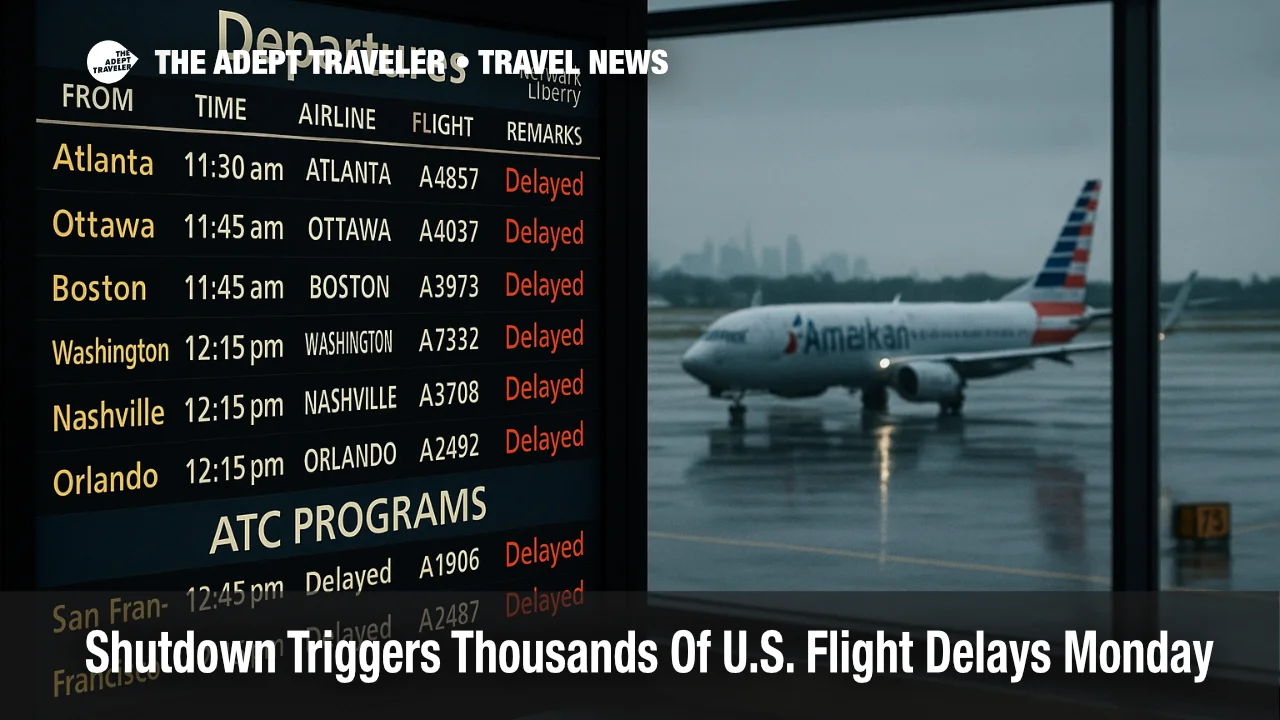Shutdown Triggers Thousands Of U.S. Flight Delays Monday

Key points
- More than 3,100 U.S. flights were delayed by mid-afternoon Monday with 118 cancellations
- FAA cites controller shortages affecting the Southeast, Newark and Los Angeles
- LAX saw a temporary ground stop Sunday, causing delays of about 25 minutes
- Sunday tallied more than 8,600 delays nationwide amid rising controller absences
- Roughly 13,000 controllers and 50,000 TSA officers are working without pay
Impact
- Expect Delays
- Plan for rolling ground stops and longer taxi and hold times at major hubs through the week
- Rebooking Options
- Monitor airline apps and email for no-fee changes as some carriers expand waiver windows
- Airport Strategy
- Arrive earlier than usual, use Clear or PreCheck if enrolled, and consider carry-on only to speed rebooking
- Route Flexibility
- When possible, switch to morning departures or connect through less-affected hubs to improve on-time odds
- Holiday Risk
- Build buffer days into Thanksgiving trips as unpaid ATC and TSA staffing pressures may worsen if shutdown continues
Air travel across the United States slowed again Monday, October 27, 2025, as the federal government shutdown deepened staffing shortages in air traffic control. By 2:40 p.m. ET, FlightAware tallied roughly 3,192 delays within, into, or out of the U.S., plus 118 cancellations. The Federal Aviation Administration (FAA) said controller absences were driving delays across the Southeast and at Newark Liberty International Airport, with ripple effects at other hubs. The squeeze follows a Sunday surge that topped 8,600 delays nationwide, a sign that system strain is compounding day to day. Travelers should pad connection times and watch airline apps for rolling waivers and rebooking options.
Federal Aviation Administration, ATC staffing and delays
The FAA reports controller shortages at multiple facilities, with the pressure most visible at Newark, New Jersey, across the Southeast, and around Los Angeles after a Sunday ground stop at Los Angeles International Airport (LAX) paused inbound traffic. While the LAX restriction lifted after roughly two hours, crews and aircraft ended the day out of position, feeding Monday's slower starts and missed departure slots. These localized constraints become national quickly because major coastal hubs anchor transcontinental flows and long-haul connections.
On Sunday, the agency also flagged staffing issues at more than a dozen locations, consistent with earlier warnings that unpaid shifts during a shutdown drive higher sick rates and secondary job conflicts. The Transportation Department has previously noted that controller absences can account for a large share of delays when staffing dips below minimums, forcing traffic-management initiatives such as ground delays, airborne flow programs, and miles-in-trail spacing that cut runway throughput.
Latest developments
As Monday progressed, delay counts climbed past 3,100 by mid-afternoon, and cancellations remained relatively modest but rising for the hour. The FAA confirmed that staffing constraints continued to slow Newark and several Southeast facilities. On Sunday, delays exceeded 8,600 after the LAX ground stop in the morning; although lifted, residual impacts lingered into the evening push across the West Coast and Mountain West.
Analysis
For travelers, the operational pattern now looks familiar. First, when a large terminal radar approach control or en-route center cannot staff all positions, the FAA reduces traffic into its airspace. That triggers ground delay programs upstream, adding buffers between arrivals. Second, once aircraft and crews miss rotations, airlines must triage, which pushes more late-day delays than morning ones. Third, if the shutdown persists into missed pay cycles, both air traffic controllers and Transportation Security Administration (TSA) officers, already working without pay, see absence rates rise. That increases checkpoint variability and can force airlines to preemptively thin schedules on peak days to protect their operations.
If you have flexibility, shift to earlier departures, which are statistically more likely to leave on time before daily disruptions stack up. Book longer connections than usual and, when possible, route through less-congested hubs. Keep push notifications on for airline apps and enroll in text alerts for gate and time changes. If your carrier posts a change-fee waiver for affected airports or dates, rebook sooner rather than later, since same-day inventory tightens quickly during rolling delays.
Background: The United States operates one of the world's most complex air traffic systems, managed by the FAA through a network of towers, approach controls, and air route traffic control centers. Even in normal times, the system depends on precisely choreographed staffing, equipment status, and weather. During a government shutdown, most FAA and TSA personnel in critical roles must work without pay. Over time, that leads to higher absence rates and pauses in training pipelines, which compounds chronic staffing deficits and can force traffic-management programs that reduce capacity at busy hubs.
Two planning notes can help. First, monitor day-of-travel airport conditions in our running update, Flight Delays and Airport Impacts: October 27, 2025. Second, if your itinerary touches a market facing additional labor actions or capacity constraints this week, such as Italy's airport work stoppages, build extra buffer time or review alternatives noted in our piece on Italy Airport Strikes on October 29. Both links provide live context for schedule planning.
Final thoughts
The primary driver of Monday's nationwide delays is the shutdown-related strain on air traffic control staffing, amplified by Sunday's LAX ground stop and rising controller absences. If the shutdown continues, holiday-period disruption risk will grow. Use early departures, longer connections, and airline app alerts to protect your plans, and rebook promptly when waivers appear to keep options open.
Sources
- More than 2,700 flights delayed as shutdown hits Day 27, Reuters
- FAA staffing issues delay flights in New York, Washington, Newark and Houston, Reuters
- Air traffic controller shortages emerge during shutdown, Reuters
- Temporary ground stop at LAX due to staffing shortage, Los Angeles Times
- LAX flights resume after FAA staffing shortage causes halt, San Francisco Chronicle
- Government shutdown live updates, Yahoo Finance
